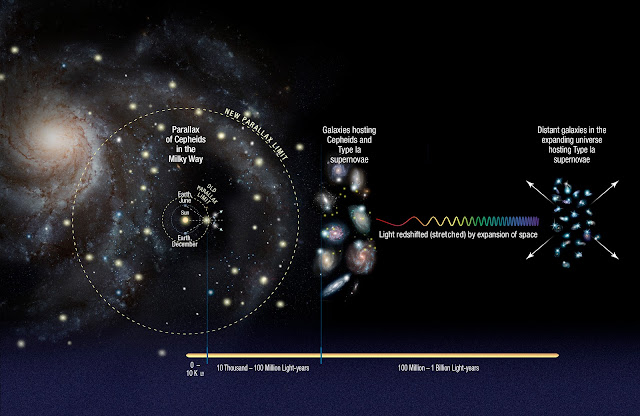Astronomers have used Hubble to measure the distances to stars in nineteen galaxies more accurately than previously possible. They found that the Universe is currently expanding faster than the rate derived from measurements of the Universe shortly after the Big Bang. If confirmed, this apparent inconsistency may be an important clue to understanding three of the Universe’s most elusive components: dark matter, dark energy and neutrinos.
A team of astronomers, led by Nobel Laureate Adam Riess and using the NASA/ESA Hubble Space Telescope, have discovered that the Universe is expanding between five and nine percent faster than previously calculated. This is in clear discrepancy with the rate predicted from measurements of the infant Universe.
“This surprising finding may be an important clue to understanding those mysterious parts of the Universe that make up 95 percent of everything and don’t emit light, such as dark energy, dark matter, and dark radiation,” explains Adam Riess of the Space Telescope Science Institute and the Johns Hopkins University, both in Baltimore, USA.
One possible explanation for this unexpectedly fast expansion of the Universe is a new type of subatomic particle that may have changed the balance of energy in the early Universe, so called dark radiation.
The team made the discovery by refining the measurement of how fast the Universe is expanding, a value called the Hubble constant, to unprecedented accuracy, reducing the uncertainty to only 2.4 percent.
This new measurement presents a puzzle because it does not agree with the expansion rate found by looking at the moments shortly after the Big Bang. Measurements of the afterglow from the Big Bang from NASA’s Wilkinson Microwave Anisotropy Probe (WMAP) and the European Space Agency’s Planck satellite mission yield smaller predictions for the Hubble constant.
Comparing the Universe’s expansion rate as calculated by WMAP and Planck (for the time after the Big Bang) and Hubble (for our modern Universe) is like building a bridge, Riess explains: “You start at two ends, and you expect to meet in the middle if all of your drawings are right and your measurements are right. But now the ends are not quite meeting in the middle and we want to know why.”
This refined determination of the Hubble constant was made possible by making precise measurements of the distances to both nearby and faraway galaxies using Hubble. The improved distance measurements were made by streamlining and strengthening the cosmic distance ladder, which astronomers use to measure accurate distances to galaxies. The team compared these measured distances with the expansion of space as measured by the stretching of light from receding galaxies and these two values were then used to calculate the Hubble constant.
The team is continuing to use Hubble with the aim of reducing the uncertainty in the Hubble constant even further, their goal being to reach an uncertainty of just 1 percent. Current telescopes such as the European Space Agency’s Gaia satellite, and future telescopes such as the NASA/ESA/CSA James Webb Space Telescope (JWST) and the European Extremely Large Telescope (E-ELT) could also help astronomers make better measurements of the expansion rate and lead to a better understanding of our Universe and the laws that govern it.
Image Credit: NASA,ESA, A. Feild (STScI), and A. Riess (STScI/JHU)
Explanation from: https://www.spacetelescope.org/news/heic1611/




Really stunning!! Many surprises to be discovered are hidden out there.....
ReplyDelete